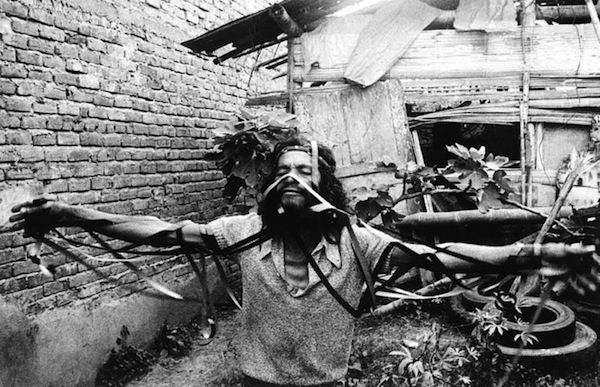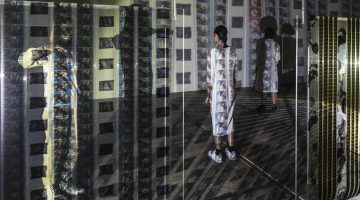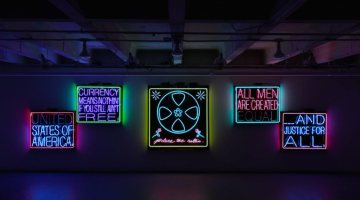
Carlos Mayolo and Luis Ospina, "Agarrando pueblo" (aka The Vampires of Poverty) (production photo), 1978; 16 mm film transferred to video, black and white and color, sound, 28 min.; Courtesy Luis Ospina; photo- Eduardo Carvajal.
The San Francisco Museum of Modern Art describes it’s exhibit “Six Lines of Flight: Shifting Geographies in Contemporary Art” as bringing together “burgeoning artistic centers”: Beirut, Lebanon; Cali, Colombia; Cluj, Romania; Ho Chi Minh City, Vietnam; San Francisco, United States; and Tangier, Morocco. Up-and-coming international art communities are not, however, the strongest thread that holds this exhibit together. Using appropriated images of their countries’ past, the artists in “Six Lines of Flight” are attempting to explain their country. They are trying to explain their national experience to themselves and to a global art market that knows little about them. They are trying to explain the domino effect of their history, how things came to be and how it felt to be there.

Lamia Joreige, "Beirut, Autopsy of a City", 2010; mixed-media installation; dimensions variable; commissioned by Mathaf, Doha, Qatar, 2010; courtesy the artist; © Lamia Joreige.
It’s an impossible task to map out centuries of a region’s history, as Lamia Joreige attempted in “Beirut, Autopsy of a City” (2010). Photographs, films, and text representing events in Beirut beginning around 2 B.C. are connected with lines representing the event by which they were begotten and it winds its way down the length of the galleries’ first corridor. The result is not beautiful in its futility, it’s exhausting. None of the images or videos are arresting enough to be memorable on their own; together they overflow with information until they lose track of their point. “Beirut, Autopsy of a City’s” lack of success is its significance, and it sets up the context for the pieces that are successful: the whole picture is too big, and the comprehensible works are just a sliver of the story.

Dinh Q. Lê, “Sound and Fury” (still), 2012; three-channel video installation; courtesy the artist; Shoshana Wayne Gallery, Los Angeles; PPOW Gallery, New York; and Elizabeth Leach Gallery, Portland, Oregon; © Dinh Q. Lê.
The best pieces in “Six Lines of Flight” are its films, many of which are plot-driven. They are long, but worth viewing in their entirety; most do not conform to contemporary art films that are unwatchable in their entirety, disguising a lack of vision with too much repetition or slow motion, (with the exception of The Propeller Group’s “The Guerrillas of Cu Chi” (2012) which is a perfect example of this unfortunate phenomenon). Dinh Q. Lê’s “Sound and Fury” (2012), a three-channel film about blind nationalism in Vietnam, has a visual and audio rhythm that builds into a slightly anxiety-inducing climax. Carlos Mayolo and Luis Ospina’s “Agarrando pueblo” (aka The Vampires of Poverty) (1978) is 28 minutes long and has some of the same crazy magic as an Alejandro Jodorowsky film. Graziella Rizkallah Toufic Jalal Toufic’s “Attempt 137 to Map the Drive” (2012) is as eerie as a ghost story. Go to the exhibit on a grey day, and stay awhile.
“Six Lines of Flight: Shifting Geographies in Contemporary Art” is on view at The San Francisco Museum of Modern Art through December 31.
-Kendall George


